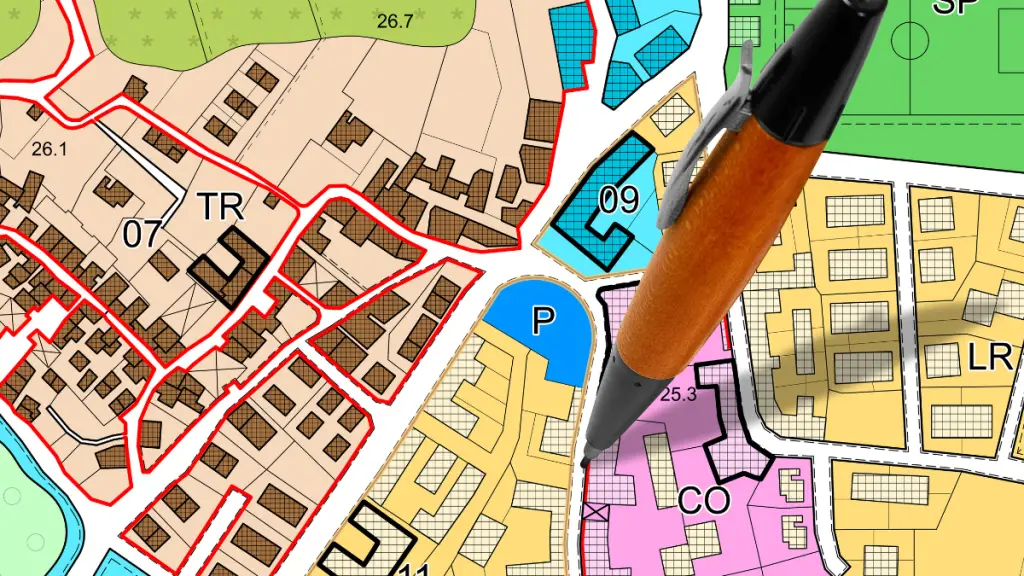Urbanization in Nigeria has been rapid and unprecedented, posing significant challenges to the country’s development trajectory. As urban populations continue to swell, accompanied by increasing demands for housing, infrastructure, and services, Nigeria faces a myriad of complex development problems. From inadequate housing and infrastructure deficiencies to environmental degradation and social inequalities, the need for effective solutions is pressing. In this context, urban and regional planning emerges as a critical tool for addressing Nigeria’s development challenges. And steering the country towards sustainable and inclusive growth.
Urban and regional planning encompasses a broad range of strategies, policies, and interventions aimed at shaping the physical, social, and economic dimensions of urban and rural areas. By guiding the spatial organization, land use patterns, infrastructure development, and socio-economic activities within cities and regions, planning seeks to optimize resource allocation, enhance quality of life, and promote equitable and resilient urban environments. In the Nigerian context, the relevance of urban and regional planning cannot be overstated, given the rapid pace of urbanization and the attendant pressures on land, resources, and governance systems.
This essay explores the potential of urban and regional planning as a transformative tool for addressing Nigeria’s development problems.
Development in the Context of Urban and Regional Planning
In the context of urban and regional planning, development refers to the intentional and systematic process of improving the physical, social, economic, and environmental conditions within cities, towns, and regions to enhance the well-being and prosperity of their residents. Development in urban and regional planning encompasses a wide range of objectives and goals aimed at creating sustainable, inclusive, and livable communities.
At its core, development in urban and regional planning involves:
1. Physical Development: This includes the design, layout, and construction of built environments, such as buildings, infrastructure, transportation networks, and public spaces. Physical development aims to create functional and aesthetically pleasing urban landscapes that support economic activities, social interactions, and cultural vitality.
2. Social Development: Development in urban and regional planning also focuses on improving social well-being and equity. This is done by addressing issues such as housing affordability, access to healthcare and education, social inclusion, and community cohesion. Social development aims to create cities and regions where all residents have the opportunity to lead fulfilling and dignified lives.
3. Economic Development: Urban and regional planning plays a crucial role in promoting economic growth, competitiveness, and prosperity by supporting job creation, business development, investment attraction, and innovation. Economic development strategies aim to foster vibrant urban economies that generate employment opportunities, enhance productivity, and improve living standards.

4. Environmental Development: Sustainable development in urban and regional planning involves minimizing environmental degradation. As well as conserving natural resources, and mitigating the impacts of climate change and pollution. Environmental development strategies seek to create resilient and ecologically sustainable urban environments that protect biodiversity, reduce carbon emissions, and enhance overall environmental quality.
5. Spatial Development: Development in urban and regional planning also encompasses the spatial organization and management of land use, transportation systems, and infrastructure networks. Spatial development aims to optimize the allocation of land and resources. Promote compact and efficient urban growth, and reduce sprawl and environmental degradation.
Challenges of Urbanization in Nigeria
Rapid Urbanization
Nigeria is experiencing one of the fastest rates of urbanization in the world, with over half of its population projected to reside in urban areas by 2050. This rapid urban growth has led to the proliferation of informal settlements, slums, and overcrowded cities, exacerbating housing shortages, sanitation issues, and social inequalities.
The strain on urban infrastructure and services, coupled with limited resources and institutional capacity, underscores the urgency of addressing the spatial and socio-economic dimensions of urbanization through effective planning interventions.
Housing Shortages and Infrastructure Deficit
One of the most pressing challenges facing Nigeria’s urban areas is the acute shortage of affordable housing and basic infrastructure. Millions of Nigerians lack access to decent housing, clean water, sanitation, and unreliable electricity, resulting in substandard living conditions and urban poverty.
Urban and regional planning can play a pivotal role in addressing these challenges by guiding the development of housing projects and infrastructure investments. As well as service delivery mechanisms that meet the needs of diverse populations and promote inclusive urban development.
Environmental Degradation and Climate Change
Rapid urbanization in Nigeria has contributed to environmental degradation, including deforestation, pollution, and loss of biodiversity, exacerbating the impacts of climate change and natural disasters. Unplanned urban expansion, inadequate waste management systems, and unsustainable land use practices have heightened vulnerability to flooding, erosion, and air pollution. Posing significant risks to public health and economic stability. Urban and regional planning can mitigate these risks by incorporating sustainable land use planning, green infrastructure, and climate adaptation measures into development strategies, enhancing resilience and reducing environmental impacts.
Social Inequalities and Urban Segregation
Nigeria’s urban areas are characterized by stark social inequalities, manifested in spatial segregation, unequal access to resources, and socio-economic disparities. Urban planning policies and land use regulations often perpetuate these inequalities, exacerbating divisions along ethnic, economic, and social lines. Addressing social inequalities requires a holistic approach to planning that prioritizes social inclusion, community participation, and equitable distribution of resources and opportunities.
By promoting mixed-income neighborhoods, affordable housing initiatives, and inclusive development projects, urban and regional planning can foster social cohesion and reduce urban disparities.
Institutional Capacity and Governance
The effectiveness of urban and regional planning in Nigeria is contingent upon robust institutional frameworks, effective governance structures, and transparent decision-making processes. However, challenges such as weak institutional capacity, bureaucratic inefficiencies, and political interference often hinder the implementation of planning policies and projects. Strengthening planning institutions, enhancing intergovernmental coordination, and promoting stakeholder engagement are essential for overcoming these challenges and ensuring that planning efforts translate into tangible development outcomes.
Role of Master Plan Designs in Addressing Development Challenges
Master plan design can play a crucial role in addressing development problems in Nigerian cities by providing a comprehensive framework for guiding future growth and development. These can be achieved through the following broad sectors:
1. Spatial Organization: Master plans can define land use zones, transportation networks, and infrastructure corridors, optimizing spatial organization to accommodate population growth, economic activities, and social needs while minimizing environmental impact.
2. Infrastructure Development: Master plans can prioritize infrastructure investments. Such as transportation systems, water supply, sanitation, and energy networks, ensuring adequate services for current and future residents and businesses.
3. Housing and Urban Renewal: Master plans can identify areas for housing development, affordable housing projects, and urban renewal initiatives, addressing housing shortages, upgrading informal settlements, and improving living conditions for urban residents.
4. Environmental Sustainability: Master plans can integrate environmental protection measures, green spaces, and sustainable development practices, mitigating pollution, conserving natural resources, and enhancing climate resilience in the face of environmental challenges.
5. Economic Diversification: Master plans can promote economic diversification by identifying areas for industrial development, commercial zones, and mixed-use districts. Attracting investment, creating employment opportunities, and fostering business growth.
6. Social Inclusion: Master plans can promote social inclusion by incorporating provisions for community facilities, social services, and public spaces accessible to all residents, regardless of income or social status, fostering social cohesion and equitable access to opportunities.
7. Disaster Risk Reduction: Master plans can incorporate measures for disaster risk reduction and management, such as floodplain mapping, evacuation routes, and resilient building standards, minimizing vulnerability to natural disasters and climate-related hazards.
8. Heritage Preservation: Master plans can include provisions for heritage preservation, cultural landmarks, and historic districts, safeguarding Nigeria’s rich cultural heritage and promoting tourism and cultural identity.
How Urban Planning Projects Can Be Funded
Funding for urban planning initiatives in Nigerian cities can be sourced through various mechanisms, including:
1. Public-Private Partnerships (PPPs): Collaborations between government entities and private sector developers can mobilize funding for infrastructure projects, housing developments, and urban renewal initiatives. While leveraging private sector expertise and resources.
2. Government Budget Allocation: Governments can allocate funds from national and local budgets to finance infrastructure projects, affordable housing programs, and poverty alleviation initiatives. Prioritizing investments in areas with the greatest need.
3. International Aid and Investment: Nigeria can seek financial assistance and investment from international organizations, development banks, and foreign governments to support urban development projects, poverty reduction programs, and housing affordability initiatives.
4. Land Value Capture: Governments can capture a portion of the increase in land value resulting from infrastructure improvements and urban development projects to fund public infrastructure and affordable housing initiatives, through mechanisms such as land value taxation or development impact fees.
5. Microfinance and Community Savings Schemes: Encouraging microfinance institutions and community-based savings schemes can provide access to credit and financial services for low-income households. Enabling them to invest in housing improvements and small-scale businesses.
How to Make Housing Affordable In Nigeria
1. Subsidies and Incentives: Governments can provide subsidies, grants, or tax incentives to developers and homebuyers to reduce the cost of housing construction or purchase, particularly targeting low-income households.
2. Regulatory Reforms: Streamlining bureaucratic processes, reducing regulatory barriers, and simplifying land acquisition procedures can lower the cost of development, making housing more affordable for developers and homebuyers alike.
3. Social Housing Programs: Implementing social housing programs that provide subsidized rental units or low-cost housing options for low-income families can increase access to affordable housing while ensuring quality standards and tenure security.
4. Housing Finance Mechanisms: Developing affordable housing finance mechanisms, such as mortgage guarantees, housing cooperatives, or rental assistance programs, can facilitate access to housing finance for low-income households with limited collateral or credit history.
How To Address Urban Poverty
1. Poverty Alleviation Programs: Implementing poverty alleviation programs, such as cash transfer schemes, vocational training, and microenterprise development, can empower marginalized communities and improve livelihood opportunities.
2. Youth Empowerment and Education: Investing in education, skills development, and job training programs for young people can reduce unemployment, enhance employability, and mitigate the risk of involvement in criminal activities.
3. Community Policing and Crime Prevention:
Strengthening community policing initiatives, enhancing law enforcement capabilities, and promoting community engagement in crime prevention efforts can improve public safety and reduce crime rates in urban neighborhoods.
4. Social Services and Infrastructure:
Improving access to essential services, such as healthcare, education, and sanitation, and upgrading infrastructure in low-income neighborhoods can enhance quality of life. And reduce socio-economic disparities that contribute to urban poverty and crime.
5. Community Development and Participation: Empowering communities through participatory decision-making processes. Community development projects and grassroots initiatives can foster social cohesion, resilience, and collective action against crime and poverty.
Crime Prevention Through Environmental Design (CPTED)
CPTED is an approach to urban planning and design that aims to reduce crime and improve safety by influencing the built environment. CPTED principles emphasize the idea that the physical layout, design, and management of urban spaces can either encourage or discourage criminal behavior. Here are the key components of CPTED:
1. Natural Surveillance: Designing urban spaces in a way that maximizes visibility and allows for natural surveillance help deter criminal activity. This includes features such as well-lit streets, clear sightlines, and open spaces that are easily observed by residents, pedestrians, and law enforcement.
2. Territorial Reinforcement: Establishing clear boundaries and ownership of space helps create a sense of ownership and responsibility among residents, which can deter potential offenders. Features such as fences, landscaping, signage, and property markers can reinforce territorial boundaries and discourage unauthorized access.
3. Access Control: Controlling access to urban spaces through physical and symbolic means can help prevent crime by regulating the flow of people and vehicles. Measures such as gated communities, controlled entry points, and security barriers can limit opportunities for criminal activity. And enhance feelings of safety among residents.
4. Environmental Maintenance: Maintaining urban environments in a clean, well-maintained, and attractive condition signals to potential offenders that the area is actively cared for and monitored. Regular maintenance, graffiti removal, landscaping, and litter control contribute to a sense of order and security in public spaces.
5. Activity Support: Encouraging legitimate and positive uses of urban spaces, such as recreational activities, social gatherings, and community events, helps deter crime by increasing the presence of people and promoting a sense of ownership and belonging. Public amenities, such as parks, playgrounds, and community centers, can support these activities and contribute to a vibrant and active urban environment.
How Urban Planning Can Improve Quality Of Life
Urban and regional planning can significantly contribute to improving a city’s quality of life (QoL) by addressing various aspects of urban development and enhancing the well-being of its residents. Here’s how urban and regional planning can aid in improving a city’s QoL:
1. Green Spaces and Parks: Planning for green spaces, parks, and recreational areas within urban areas provides residents with access to nature, opportunities for physical activity, and spaces for social interaction, which contribute to better mental and physical health.
2. Walkability and Accessibility: Designing cities with pedestrian-friendly infrastructure, such as sidewalks, crosswalks, and pedestrian bridges, promotes walkability and enhances accessibility, allowing residents to easily access amenities, services, and public transportation options without relying on cars.
3. Public Transportation: Planning for efficient and reliable public transportation systems, including buses, trains, and metros, reduces traffic congestion, air pollution, and commuting times. They improve mobility and accessibility for residents while promoting sustainable transportation alternatives.
4. Mixed-Use Development: Encouraging mixed-use development that integrates residential, commercial, and recreational spaces within neighborhoods promotes vibrant urban environments, fosters economic activity, and reduces the need for long commutes, enhancing convenience and quality of life for residents.
5. Affordable Housing: Implementing policies and programs to promote affordable housing, such as inclusionary zoning, housing subsidies, and mixed-income developments, ensures that residents have access to safe, decent, and affordable housing options, addressing housing affordability challenges and promoting social equity.
6. Environmental Sustainability: Incorporating sustainable design principles, renewable energy sources, and green building standards into urban development projects reduces environmental impact, mitigates climate change, and enhances resilience to natural disasters, safeguarding the health and well-being of current and future generations.
7. Social Services and Amenities: Planning for the equitable distribution of social services, amenities, and community facilities. Such as schools, healthcare centers, libraries, and community centers, ensure that residents have access to essential services and opportunities for education, healthcare, and social interaction, promoting social inclusion and cohesion.
8. Cultural and Heritage Preservation: Integrating cultural heritage preservation into urban planning efforts, such as revitalizing historic districts, preserving cultural landmarks, and promoting cultural tourism, celebrates local identity, fosters a sense of belonging, and enriches the cultural fabric of the city.
How Urban and Regional Planning Boosts Gross Domestic Product (GDP)
Urban and regional planning plays a crucial role in boosting a city’s GDP by creating an environment conducive to economic growth, innovation, and investment. Here are several ways in which this can be achieved:
1. Infrastructure Development: Strategic planning for infrastructure projects, such as transportation networks, utilities, and telecommunications, enhances connectivity and reduces transportation costs. It also improves access to markets, facilitating trade and commerce and stimulating economic activity.
2. Industrial and Commercial Zones: Zoning regulations and land use planning that designate areas for industrial parks, commercial districts, and business clusters attract investment. It promotes business expansion and creates employment opportunities, contributing to economic diversification and GDP growth.
3. Innovation Hubs and Technology Parks: Planning for innovation hubs, technology parks, and research clusters fosters collaboration between academia, industry, and government. It promotes knowledge exchange and technology transfer and stimulates innovation and entrepreneurship, driving economic growth and competitiveness.
4. Mixed-Use Development: Encouraging mixed-use development that combines residential, commercial, and recreational spaces within urban areas promotes vibrant urban environments, stimulates consumer spending, and supports small businesses, enhancing local economic activity and GDP.
5. Tourism and Cultural Heritage: Planning for tourism infrastructure, cultural amenities, and heritage preservation initiatives attracts visitors, generates tourism revenue, and creates jobs in hospitality, retail, and entertainment, contributing to economic growth and GDP.
6. Housing and Real Estate Development: Planning for housing development, urban renewal, and real estate projects stimulates construction activity, creates employment opportunities in the construction sector, and generates demand for goods and services, boosting local economies and GDP.
7. Sustainable Development Practices: Integrating sustainable development practices into urban planning, such as energy efficiency measures, green building standards, and environmental conservation initiatives, reduces operating costs, enhances resource efficiency, and promotes economic resilience, contributing to long-term GDP growth.
Nigerian Politics, Policies and Urban Planning
The link between Nigeria’s politics and governance and its urban and regional planning exploits is significant and multifaceted. Here are several key aspects of this relationship:
1. Policy Formulation and Implementation: Nigeria’s political landscape and governance structures influence the formulation and implementation of urban and regional planning policies and strategies. Decisions related to land use, infrastructure development, zoning regulations, and environmental protection are often shaped by political priorities, interests, and power dynamics.
2. Resource Allocation and Budgeting: The allocation of resources and budgetary priorities by government authorities, including federal, state, and local governments, impacts the implementation of urban and regional planning initiatives. Political decisions regarding funding for infrastructure projects, housing programs, and public services influence the scale and effectiveness of planning efforts.
3. Institutional Capacity and Coordination: The effectiveness of urban and regional planning in Nigeria is closely linked to the capacity and coordination of government institutions responsible for planning and development. Political leadership, administrative structures, and intergovernmental relations can affect the efficiency, transparency, and accountability of planning processes.
4. Regulatory Framework and Enforcement: The regulatory framework governing urban and regional planning, including laws, regulations, and enforcement mechanisms, is influenced by political factors such as legislative priorities, policy agendas, and vested interests. Political will and commitment are essential for enforcing planning regulations and addressing issues such as illegal construction, land grabbing , and environmental degradation.
5. Stakeholder Engagement and Participation: Political dynamics shape stakeholder engagement and participation in urban and regional planning processes. The extent to which communities, civil society organizations, and private sector actors are involved in decision-making, consultation, and implementation varies depending on political will, openness to citizen input, and the level of decentralization and devolution of power.
6. Corruption and Transparency: Nigeria’s political environment can impact the prevalence of corruption and transparency in urban and regional planning practices. Political interference, rent-seeking behavior, and patronage networks may undermine the integrity of planning processes, leading to inefficiency, mismanagement, and the misallocation of resources.
7. Policy Stability and Long-Term Planning: Political stability and continuity are essential for long-term urban and regional planning efforts. Changes in government leadership, policy direction, and political priorities can disrupt planning processes, impede implementation, and undermine the effectiveness of planning interventions.
Conclusion
In conclusion, urban and regional planning is a vital tool for addressing Nigeria’s development challenges. And steering the country towards sustainable and inclusive growth. From tackling housing shortages and infrastructure deficits to mitigating environmental degradation and social inequalities, planning interventions offer tangible solutions to complex urban problems. By harnessing the power of planning to guide urbanization, manage resources, and promote social equity, Nigeria can build vibrant, resilient, and prosperous cities and regions for present and future generations.
However, realizing this vision requires political will, institutional capacity, and community engagement to overcome challenges and maximize the potential of planning as a catalyst for development. With concerted efforts and strategic planning interventions, Nigeria can pave the way for a more prosperous and sustainable future for all its citizens








